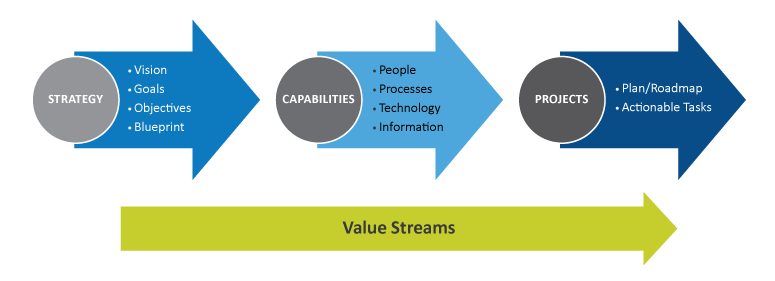One View of Business Architecture

Business architecture can be a broadly used term, and depending on your organization, may have many different connotations. For our discussion, let’s use the OMG definition of, ”A blueprint of the enterprise that provides a common understanding of the organization and is used to align strategic objectives and tactical demands.”* What this really means is the Business Architecture is the organizational mapping that ties the Strategy (Goals, Objectives, and Vision of the Business) through the Capabilities or the Building Blocks of the Organization (People, Processes, Technology, and Information) involved in the Plans, Projects, and actionable tasks to move the organization forward. Value Streams are stretched across the bottom because they are great for managing the business context of your Architecture.
Every Business Architecture starts with the Strategy. You could really say the Architecture itself is born from the Strategy and is Strategic at its Core. Strategies can be, and usually are, part of the Strategic Planning cycle, although that term is misleading itself. A major piece of having a successful Architecture is the constant managing and reviewing of your strategy and Direction. Cycles can be assumed to be longer than they should be. You can start with an Organizational Vision of the Direction that you are going or need to move to, which is then comprised of Goals (both Short and Long Term) you have to accomplish to get there. These Goals then are comprised of Objectives (specific target reached by set dates). All of this combines to create a Blueprint of moving your organization from Current State to its Vision.
Moving onto Capabilities, the ire of many Architects, at least in explaining them and their use to non-architects. To me, Capabilities (or Competencies) are Building Blocks of your Business Architecture. They include the Processes, People, Technology, and Information. Capabilities in the simplest terms are the Abilities for the organization. Frequently, there are discussions on the difference between Capabilities and Processes. Briefly, Capabilities are “what” the business does – they are stable and rarely change. Processes, on the other hand, are “how” the business fulfills these capabilities, and they can change frequently – like a process being automated. So, take the Process and add in the Roles or jobs that own or perform these processes, the systems or tools they use to complete them, and the information used to complete it, or created as part of it, and we have the Business Capability.
Then we have the Projects, the actionable plans on the capabilities driven by the Strategy. These are the Programs, Projects, or Tasks identified to get you from your current state Capabilities to your Future State Capabilities as identified by your Strategy.
Finally, we have your Value Stream (Value Chain, End to End Map) this can be represented and used in very different ways. But for now, let’s just say it is the End to End view of “how” you deliver Customer or Stakeholder Value. I typically use these as a way to pull my “Architectural Building Blocks” and put them in the Business Context. For Instance, your Process Architecture may be based on a Process Framework like the APQC PCF that Categorizes the Processes Functionally. The Value Stream is the way the Business sees those Processes rationally stitched together. This is where most of your users will find value and understanding in the libraries of objects that you put into your Architecture.
To summarize, a complete Business Architecture contains four main areas: The Strategy that provides your Vision and Direction for your Organization. The Capabilities that provide the Building Blocks of your Organization, The Projects that provide the Change in your Organization, and the Value Streams that provide your Business Context.

